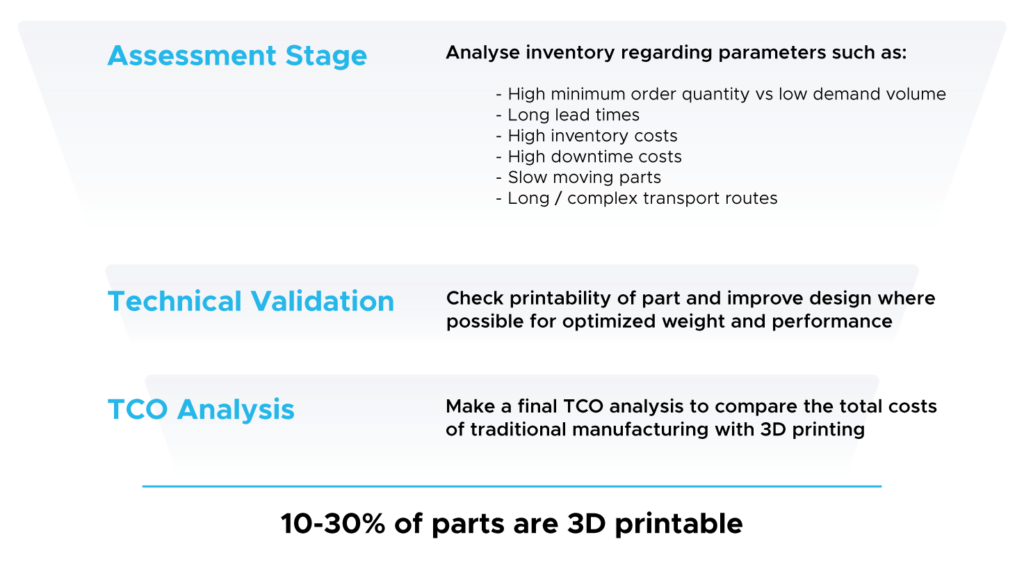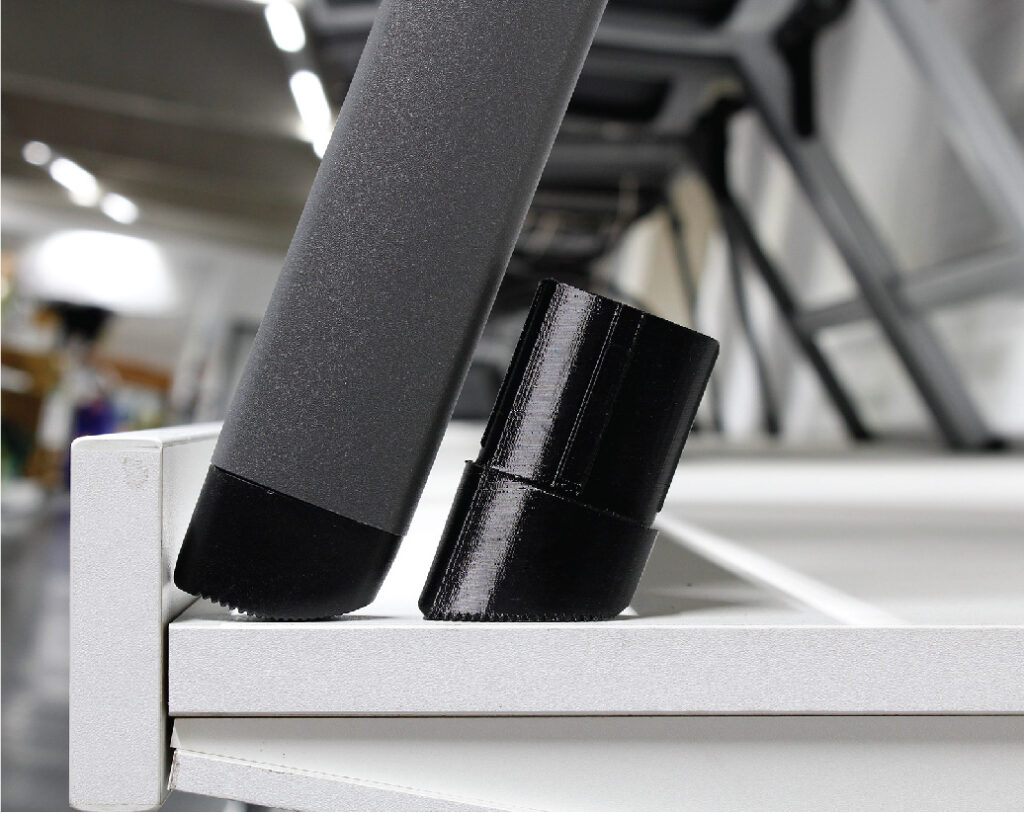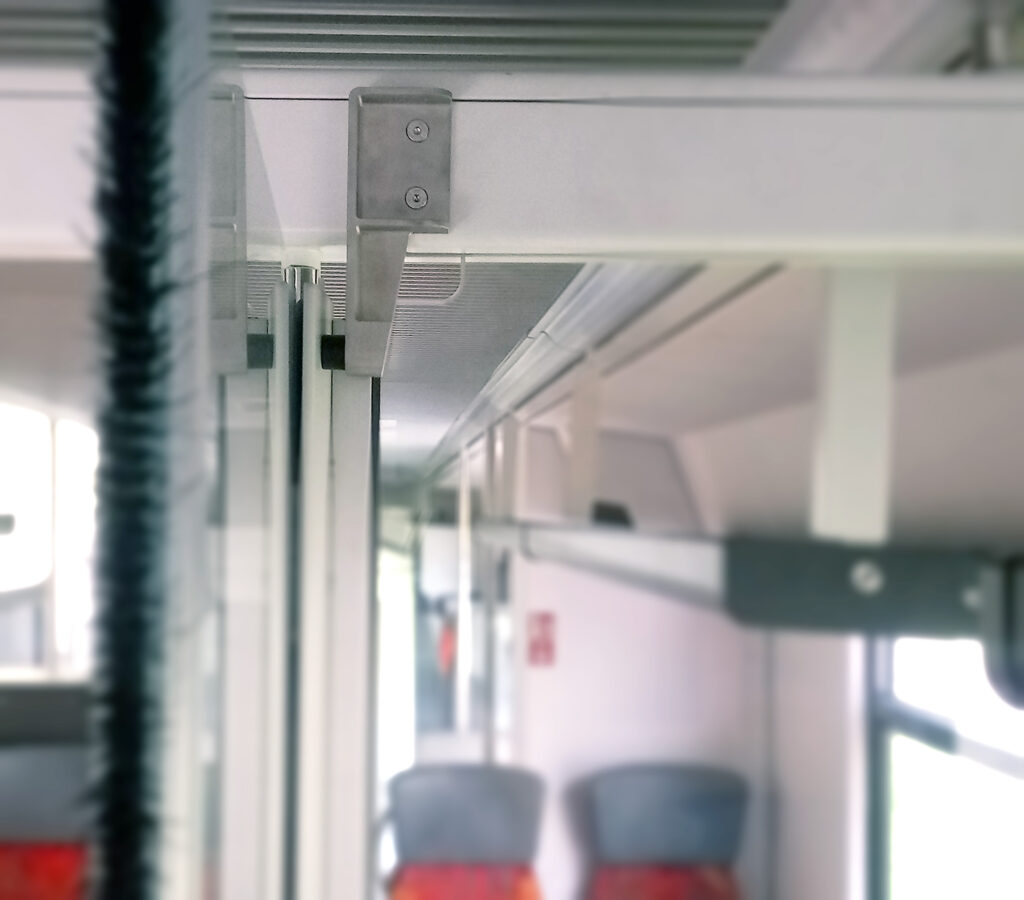3D printing (Additive Manufacturing = AM) has revolutionized the manufacturing industry, allowing businesses to create complex and customized parts with ease and move towards on-demand production. However, finding the right parts for additive manufacturing can be a challenging task, especially for those who are new to the technology. The quality of the parts chosen to print can greatly impact the outcome of the 3D printed part. In this article, we therefore want to give a 3-step-guide from a supply chain perspective that can help lead companies through the selection process and maximize the benefits of 3D printing, from the assessment stage to a technical validation and TCO analysis.

1. Assessment Stage
The first stage is to analyze the inventory to identify pain points, such as long lead times, high minimum order quantities, or location-related challenges, e. g. difficult transport routes or express airfreight costs. Companies have to ask themselves about the next best alternative when delivering the parts in traditional manufacturing and what the costs of that would be. Not just the procurement price per part, but the total costs including inventory, logistics and downtime costs. For a first quick assessment, the following matrix could be used.

Parts with low demand and lower criticality
Additive manufacturing is particularly suitable for parts with low volumes, as there are no minimum order quantities and no ramp-up costs, leading to a competitive advantage. Companies should therefore check the number of parts required per year vs. the minimum order quantity for the part. If there is a huge gap between the two numbers, 3D printing could be a great solution to avoid overproduction, storage and disposal of thousands of unused parts.
The cost-efficient production for low volumes in 3D printing makes it suitable to ramp-up production until actual demand is established, but also to produce rarely or unexpectedly requested spare parts. As 70-90% of the spare part inventory consists of slow-moving parts, there could be a huge potential to free up resources and save costs.


Parts with low demand and high criticality
When a part is critical for the product or process, 3D printing becomes mandatory, as downtimes can lead to huge losses in revenue and customer satisfaction. Long lead times and huge downtime costs for the specific part are two important factors to look at when analyzing your inventory. Especially parts with long service periods (e. g. more than 15 years) could be produced with additive manufacturing, as traditional manufacturing may have difficulty sourcing them. This applies for example to parts for production machinery, where one minute of downtime could cost several thousands of euros (in the automotive industry e.g. one minute costs up to 22.000-50.000 Dollar, according to Thomas).
Parts with high demand and low criticality
Even for high-volume parts, where traditional manufacturing is generally the more cost-effective solution, setting up additive manufacturing as a supplementary manufacturing method might be economically attractive, giving the OEM the ability to react quickly in case of emergencies. Here, 3D printing can be used as a backup solution. Especially for parts requested globally, 3D printing could even more mitigate the risk of delivery delays, as the part can easily be produced at any local print farm close to the consumer. This also eliminates the need of long custom procedures and expensive express shipments.
2. Technical Validation

The second step is the Technical Validation, where the parts are evaluated to ensure they are 3D printable. This includes parameters such as size, materials, and overhangs. This process becomes easier with the availability of CAD files of the designs rather than just technical drawings. Software tools can help identify the right AM technology and material, as well as potential issues when printing and recommend solutions to optimize the parts’ design for 3D printing. Redesigning a part for 3D printing can greatly improve the cost of the final part, as additive manufacturing enables the creation of hollow and intricate structure, which reduces the amount of material required while maintaining strength. This is particularly useful in applications where weight is critical, such as aerospace or automotive industries. Moreover, components that have conventionally been manufactured as assemblies, composed of multiple pieces, could benefit from 3D printing technology, as the part could be produced in a single piece.
3. Business Validation: TCO Analysis
With the technical validation completed, the final business validation starts. With the help of a total cost of ownership (TCO) analysis. you evaluate the economic feasibility of producing the parts through 3D printing compared to traditional manufacturing. On one side, you consider factors such as the cost of the printer and maintenance, the cost of materials, and the cost of post-processing and finishing, or when working with an external printing provider the costs of the part using their service.
On the other side you need to evaluate the benefits of 3D printing, such as reduced lead times, reduced inventory costs, and reduced transportation costs. This might be more difficult to evaluate compared to just looking at the production/purchase price of the part with traditional manufacturing. However, these more hidden costs play a huge role in the total cost of your part.
Various cases have shown an output of up to 30% of 3D printable part is feasible.

Selecting the right parts for 3D printing is critical to ensure a successful and high-quality 3D printing experience. The three key steps – Assessment Stage, Technical Validation, and Business Validation including TCO Analysis – can help guide companies through the selection process, enabling them to reap the benefits of additive manufacturing. If internal resources are missing to evaluate the technical feasibility, platforms like Replique can be a huge lever to make use of the technology.



